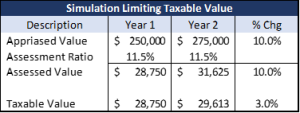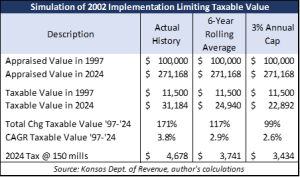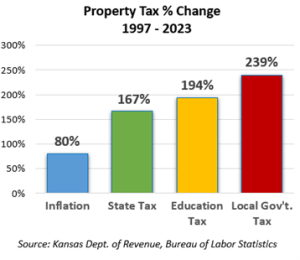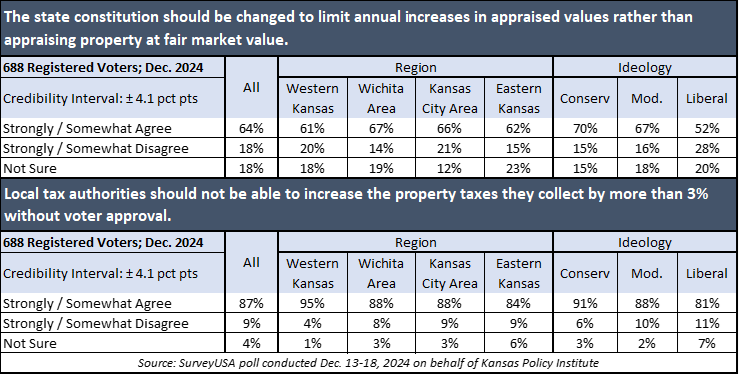Last week, the Kansas Senate passed a constitutional amendment that limits the increase in taxable real estate valuations to 3% annually. SCR 1603 applies to all real estate and mobile homes, considered personal property under Kansas law. The limit would not apply when:
- The property includes new construction or improvements have been made;
- The class or subclass of the property changes for assessment rate purposes;
- The property becomes disqualified from exemption;
- The property is first listed as escaped or omitted property or
- The legal description of the parcel changes, except the valuation of all property affected by a legal description change would not be permitted to exceed 3 percent of the total valuation of the affected property of the previous year.
House Speaker Dan Hawkins says he doesn’t have the two-thirds majority needed to pass a constitutional amendment and has no plans to have House members vote on SCR 1603. Instead, the House will introduce its version of an assessment limit, according to Sunflower State Journal.
The House plan in HCR 5011 would use the lesser of the actual change or a rolling average of an unspecified number of years to be determined by Legislators and only apply to residential property. In contrast, the Senate’s plan is the lesser of the actual change or a 3% fixed annual cap and applies to all real estate classes. The House plan goes into effect on January 1, 2027, one year later than the Senate plan. The one-year delay seems designed to allow the Legislature to determine the number of years in the rolling average if voters approve the constitutional amendment in November 2025, but that means voters won’t really know the amendment’s potential impact because the term of the rolling average isn’t specified in the House plan.
There are other nuances between the two plans, but the timing, formula, and applicability are the significant differences.
According to SSJ, the House believes the Senate plan “creates disparities between a home’s fair market value and the taxable value,” but so would the House plan. In fact, the taxable value of all real estate already differs from market value because of assessment ratios in the Kansas constitution. For example, residential property is taxed at 11.5% of appraised value, commercial and industrial real estate at 25%, and agricultural property at 30%.
There are also concerns with both plans deviating from appraising property at fair market value. However, limiting the increase in taxable value rather than on the appraised value may eliminate most of those fears.
 The language in SCR 1603 limits “the final taxable appraised value.” Amending SCR 1603 to change the word ‘appraised’ to ‘assessed’ and limiting the increase in assessed valuations would result in appraised values (allegedly) staying at market value.
The language in SCR 1603 limits “the final taxable appraised value.” Amending SCR 1603 to change the word ‘appraised’ to ‘assessed’ and limiting the increase in assessed valuations would result in appraised values (allegedly) staying at market value.
The adjacent table simulates how this would work on a home appraised at $250,000. Residential property is assessed at 11.5% of appraised value ($28,750 in the example). Let’s say the appraised value goes up 10% next year to $275,000. The assessed value would also increase by 10% to $31,625, but legislation saying the increase in assessed value may not exceed 3% puts it at $29,613. This change allows a 10% increase in appraised value but only a 3% increase in the taxable assessed value.
Comparison of a 6-year rolling average and a 3% cap on valuations
The Sunflower State Journal article says the House plans a six-year rolling average, so we’ll compare that to the Senate plan.
The adjacent table shows what would have occurred if the House and Senate plans had been implemented in 2002 (to allow for a six-year average) with limits on the taxable assessed value described above on a home appraised at $100,000 in 1997.
 According to the Kansas Department of Revenue data, both plans have the same appraised value as of today, based on the average increases on existing property. Residential property is assessed at 11.5% of appraised value, making the assessed taxable value of the home increase from $11,500 in 1997 to $31,184 today. Under the House plan, the taxable assessed value would be $24,940 and the homeowner would pay $3,741 at 150 mills. The homeowner saves more under the Senate plan, paying $3,434 on a taxable value of $22,892.
According to the Kansas Department of Revenue data, both plans have the same appraised value as of today, based on the average increases on existing property. Residential property is assessed at 11.5% of appraised value, making the assessed taxable value of the home increase from $11,500 in 1997 to $31,184 today. Under the House plan, the taxable assessed value would be $24,940 and the homeowner would pay $3,741 at 150 mills. The homeowner saves more under the Senate plan, paying $3,434 on a taxable value of $22,892.
Under current law, the homeowner would pay $4,678 today with no valuation limit. Both plans would have produced savings, but the actual savings of both plans would probably be less because local elected officials would likely have imposed higher mill rates. However, the impact of mill rate increases on their re-election chances would likely soften the rate hikes and still leave homeowners with savings.
See here for the changes by year.
The one-year implementation plan in the House plan is practically an invitation for county appraisers to jack up valuations before any rolling average applies.
Another downside of the House plan relative to the Senate plan is the potential impact on future appraised values. Phasing in increases with a 6-year rolling average makes it easier for appraisers to raise values because the homeowner will only feel a small portion of the impact each year. Appraisal hikes have no impact with a fixed cap on taxable values.
Only applying a cap on residential taxable values in the House plan also raises the possibility of shifting the tax burden to other classes of real estate, like agriculture and commercial/industrial property.
Regardless of how all this shakes out – the final product in situations like this typically includes elements of both plans – the House deserves credit for bringing an alternative for consideration. Otherwise, the issue would likely die if two-thirds of House members won’t support the Senate plan.
Limit tax increases without voter approval
As noted earlier, valuation limits prevent property owners from large spikes, but they also likely result in local officials charging higher mill rates. Legislators can blunt that temptation by also limiting the percentage increase in tax collections for local government entities without voter approval.
A tax limit can be accomplished by changing state law, which only requires a simple majority to pass and could go into effect July 1 of this year, whereas a constitutional amendment requires a two-thirds majority to reach the November ballot and take effect in January 2026. Of course, Governor Kelly is likely to veto a tax limit as she routinely takes the side of local government and school administrators over taxpayers and students, so a two-thirds majority is needed to override her veto of a statutory change.
A statutory change could be made to the existing revenue-neutral law, which requires elected officials to notify taxpayers that they intend to exceed revenue-neutral and hold a public hearing before voting on the increase. A sentence could be added saying that exceeding revenue-neutral by more than 3% requires voter approval on the August primary ballot. Therefore, the results would be known before revenue-neutral hearings begin on August 20 and several weeks before budgets must be finalized.

Some people fear that a 3% tax limit would ‘lock in’ a 3% increase each year, but that would be a welcome relief when compared to the historical reality. The average tax increase on residential property since 2018 is 6.3%, and the average change on all real estate (including commercial/industrial, agricultural, and other classes of real estate) is 5.0%; that includes changes from new construction, but the change on existing property would still be well above 3%.
Shaving mill rates is not enough
It is hard to predict how the House and Senate will resolve their differences, but doing a valuation or a tax limit (or both) is an absolute must for taxpayers.
 There is consideration of minor reductions to the 20 mills the state collects for school funding and raising the exemption on that tax for homeowners. Another thought is eliminating the 1.5 mills the state collects for state building maintenance. Both are good changes, but fall far short of what taxpayers need. Also, both measures insulate school districts and other local entities, which collectively account for 99% of all property taxes, from having to take taxpayers into consideration.
There is consideration of minor reductions to the 20 mills the state collects for school funding and raising the exemption on that tax for homeowners. Another thought is eliminating the 1.5 mills the state collects for state building maintenance. Both are good changes, but fall far short of what taxpayers need. Also, both measures insulate school districts and other local entities, which collectively account for 99% of all property taxes, from having to take taxpayers into consideration.
The 2024 county-level data is not available, but local governments hiked property tax collections by 239% between 1997 and 2023. That is three times the rate of inflation, with only a 12% population increase. Tax increases from schools and community colleges are almost as bad, with a 194% increase.
Kansans also strongly favor limits on valuations and property taxes, according to a public opinion poll conducted on our behalf by SurveyUSA.
64% of taxpayers want a valuation limit, and only 18% are opposed. Approval of a 3% tax limit is even greater, with 87% approval and only 9% opposed.

Saving a few bucks from shaving state mill rates is not enough. Legislators must come together to take substantive action with limits on valuations or taxes…or both.





